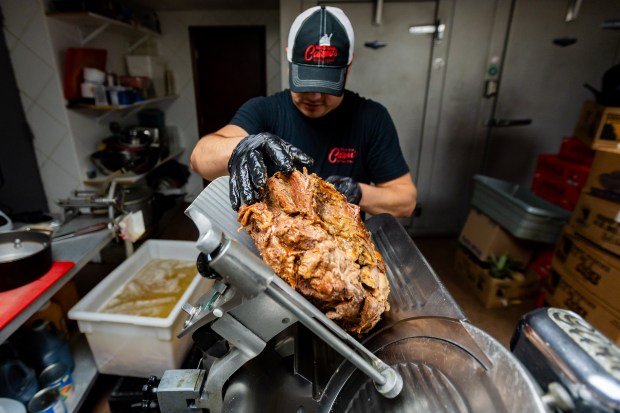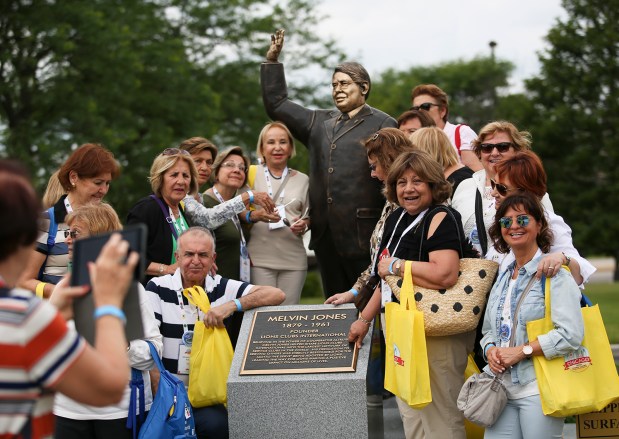“Never heard of ‘The Bear,’” Mary Fontano said, the smell of giardiniera and salted meat in the air in Little Italy. She is a co-owner of the original Fontano’s Subs on Polk Street, alongside her brother, Neil Fontano. The family business has been a fixture of this otherwise residential block for nearly 100 years. She turned to the customers lined up to pay for their Italian beefs.
“You hear about ‘The Bear?’” she asked a man in a reflective construction vest holding a wrapped sandwich.
“‘The Bear?’” the customer asked. “What’s that?”
Food spaces all across Chicago seem to be buzzing about the show. But not here.
In FX’s “The Bear,” a major question is how family-owned restaurants survive the intense stress and conflict of the kitchen. In the intertwined stories of Fontano’s and its cousin establishment, Carm’s Beef and Italian Ice, there are parallels worth considering, even as the staff keeps a healthy distance from the show.
When I moved to the city two years ago, the show’s first season, and trips to Little Italy, were my introduction to Chicago’s Italian beef culture. In the show, Carmen “Carmy” Berzatto (played by Jeremy Allen White) returns from New York to the Midwest to run his late brother’s deli in River North, bringing fine dining sensibilities to a neighborhood spot. Visits to Fontano’s and Carm’s sometimes feel like the show has come to life.
Brandon Figueroa started working the deli counter at Fontano’s in April; the 21-year-old was the rare person in the store who seemed excited and interested in the show.
“I feel like I’m in ‘The Bear,’” Figueroa said, describing his busiest days.
In 1929, the Fontano family set its roots down on the corner of Polk and Carpenter streets with a grocery store. They also sold Italian ice in the summer. Eventually, the family shifted the grocery store to the location across the street, which is now known as Fontano’s Subs. The original building sold Italian food and ice, adopting the name Carm’s.
The original owners, James and Mary Fontano, passed down the business to their kids and other family members. Eventually, their daughter Mary Devivo ran Carm’s while their son Aniello “Red” Fontano ran Fontano’s Subs. That generation then passed the businesses down to their kids. Steve Devivo took over Carm’s, while Mary and Neil Fontano took over Fontano’s. The two businesses are first cousins — all tied back to their grandparents.
Each generation running the restaurant found ways to survive by introducing new ideas to an old style of business.
Red Fontano began selling sandwiches of sliced Italian meats like the “Wiseguy” or “Blockbuster” in the early 1960s due to increased demand from construction workers who were working on what is now the University of Illinois Chicago. Neil Fontano and his team introduced a Tuesday/Thursday pot roast special variation of their Italian beef that can be ordered with optional peppers, cheese and dip. At Carm’s, the Devivos experimented with new flavors for their Italian ice and added a few Mexican items suggested by staff.
This all requires 12 or more hours of hands-on work a day. No time for TV.
In 2021, Steve Devivo of Carm’s decided to retire to Florida due to burnout.
“You have no life,” Devivo said. “The restaurant business is the toughest business in the world. You live in that place.”
He hadn’t brought his kids into the family business. In the end, rather than selling, Devivo decided to keep Carm’s going by passing the day-to-day operations down to longtime employees Beatriz Martínez and Ignacio “José” Hernández.
“I really believe in my heart, I owe this to Beatriz and José,” Devivo said, describing their long years of loyalty and hard work. “I owe them the opportunity to better their lives financially and to give them the opportunity to carry the torch.”
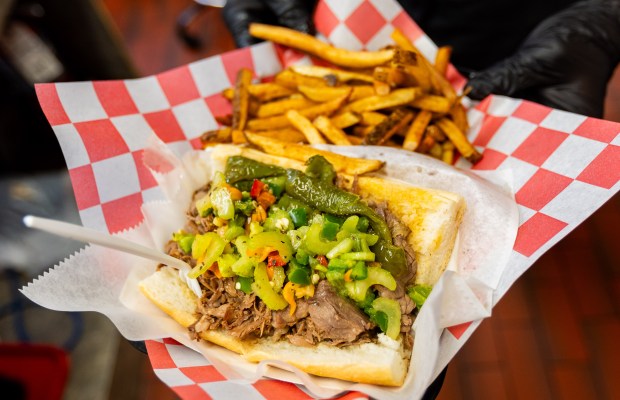
Carm’s is smaller than Fontano’s. But they share resources; frequently, when Carm’s runs out of bread, they go to Fontano’s. When Fontano’s runs out of lettuce or tomatoes, they go to Carm’s.
But there’s a bit of a rivalry too: Customers told me one restaurant is better than the other or that the giardiniera at one place isn’t real giardiniera or that one place makes more stuff in-house. And so on.
But the differences are splitting hairs between the family restaurants.
There’s an old school, neighborhood vibe to both restaurants that might have insulated them from “The Bear” hype. They’ve built their businesses on a deep connection with locals.
In Season 3, Carmy has fully transformed The Original Beef into The Bear, a fine-dining restaurant (which real-life kitchen staff pretty much all agreed was a baffling idea).
When I drove by Carm’s in Little Italy in 2022, I foolishly thought: “The name Carm’s is close to Carmy! There must have been a real Carmy Berzatto that inspired the show!”
I was completely wrong, of course. The show is actually inspired by Mr. Beef, a River North store.
Martínez, who works the front of the house at Carm’s while Hernández works the back, laughed with a bit of confusion when I asked her about “The Bear” around Season 1’s release. She said “The Bear” sounded vaguely familiar, but she hadn’t seen it.
When Season 3 of the show came out, I asked her again.
“Remember when I asked about ‘The Bear?’”
“Yeah. Still haven’t seen it.”
I howled. “That’s amazing.”
“I’m too busy. I don’t have time for it.”
She did get a kick out of the fact that the main character shared a name with their restaurant. Carm’s was named after Carmella Fontano, the youngest child of the original owners. She ran the restaurant for a period until she passed it to the Devivos in the ‘70s.
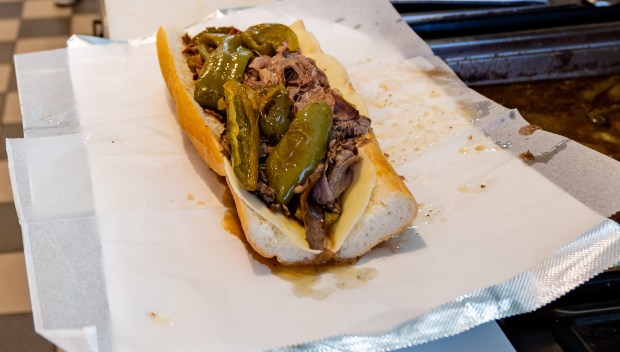
When I asked staff at Fontano’s and Carm’s about the show they hadn’t seen, I found it did closely mirror their world.
The obvious first question: how was the show’s beef preparation and how do you make it?
“I cannot knock on this or that,” Martínez said, watching the footage of Carmy preparing sandwiches for the first time. “Everybody makes their beef different.”
Fernando Villegas, who oversees the kitchen at Fontano’s, described their beef recipe to me: After a day of rest with seasoning, the beef is roasted for three hours in the oven. It rests again, and then it’s sliced and cooked again in the oven with its juices and sweet peppers.
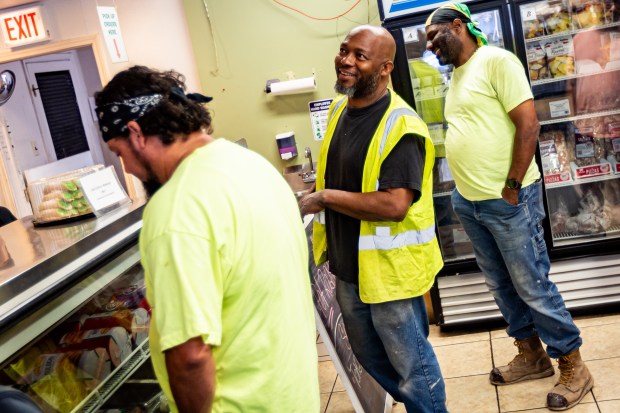
But beyond the food, there are unusual overlaps between “The Bear” and these two beef shops in Little Italy. Perhaps it’s the long history. Perhaps it’s the nature of restaurants. Perhaps it’s all beef shops in Chicago.
Some of the similarities are simple: the battle over new menu items. In Season 1, Carmy relied on new employee Sydney Adamu (played by Ayo Edebiri) to control the chaos and rebellion in his kitchen. But there was tension too, when he tried to remove some classic menu items and didn’t fully embrace Sydney’s new suggestions.
At Carm’s, Hernández also struggled to make additions at first.
“I told Steve, ‘Why don’t you put Mexican food on the menu?’” Hernandez said.
Devivo said when he asked his mother, who for many years cooked the food at Carm’s, she was not happy.
“My ma was totally against it,” Devivo said. “You can just imagine what came out of her mouth when I ran that past her.” But Devivo had Hernández prepare a sample of the tacos and approved them.
Hernández has now served his house-made tacos and salsas on El Popocatepetl tortillas for about 10 years next to the Devivo family’s Italian beef and chicken sandwiches.
“It was a hit from jump street and it generated more income to the corner,” Devivo said, even as other local traditionalists balked. “I will tell you that the neighborhood people were skeptical from the beginning.”
But Devivo stood behind his employees. They speak fondly of each other and stay in touch on a regular basis, even as Devivo stepped away from the restaurant for the last three years.
When I showed Martínez photos of Mikey Berzatto, played by a wolfish Jon Bernthal on the show, she exclaimed, “That looks like Steve!” She pointed to a picture hanging near the door of Devivo in a yellow hat and blue shirt.
Over at Fontano’s, tragedy struck the restaurant family much like the Berzattos of “The Bear.”
Starting in 1975, Mary Fontano’s brother, Jimmy Fontano, oversaw the running of their namesake restaurant.
“Jimmy was my dad’s heart,” Mary Fontano said. “He worked in this store from when he was 18 years old.”
The expectation was that Jimmy would succeed their father, Red Fontano, but Jimmy died unexpectedly in 2012.
“I had a really bad time when Jimmy left,” Mary Fontano said. “It was hard for me … Just hard to walk in and make sandwiches and Jimmy not be in there.”
In the show, Mikey Berzatto’s unexpected death infuses the restaurant with grief and conflict, and brings Carmy back home to the family business.
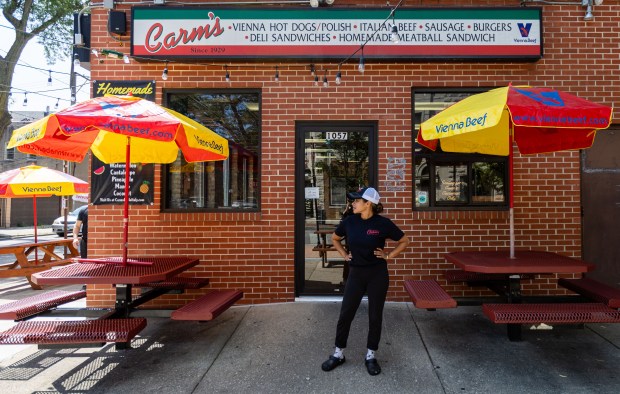
In the real-world version, the youngest brother also returned to help the family’s recovery.
“I related to the fact that (Carmy) came back,” said Neil Fontano, who watched the first season. “Because that’s what I did.”
After Jimmy died, Mary took a break from working in the store. Unlike other siblings, Neil had not worked nearly as much in the store; he had a real estate career in Las Vegas. He also kept an eye on franchise locations (there are three other Fontano locations besides the original, though there were once many more).
Red Fontano made the two siblings managers with Neil taking the lead; they eventually became co-owners when Red died in 2021.
Increasingly, the two siblings are thinking about retiring.
Neil’s only son, Aniello Fontano, works in Hollywood; Neil said, “I never wanted my son in this business.”
Neil described the work like a marriage, where all your hours spent together may come with love, but leads to inevitable arguments and stress. Devivo agreed.
“I totally could relate to all the drama behind the counter,” Devivo said of “The Bear.” “How they always argued amongst each other.” But Devivo said he had no interest in watching beyond what he saw in the first season. Neil Fontano also said the same, having only watched after his son asked him to.
When asked about Fontano’s succession plan, Mary Fontano said she could not answer.
“That would start a family problem,” she said. “I’ve always promised my dad as long as I was alive the lights would stay on.”
Other transitions happened long ago. Fontano’s was for many years only run by family members. Their first nonfamily employee was Angelica “Angie” Pérez, who has worked with the family for 30 years.
Through this hiring, a second family began building its own legacy: Pérez helped her sister Beatriz Martínez get a job across the street at Carm’s in 1997.
“I did not know what Italian beef was,” Martínez said.
The sisters have been the face of parallel Italian delis for coming up on three decades, starting another family tradition. At Fontano’s, Pérez runs the front like her sister.
They speak Spanish frequently with visitors and employees. Pérez was born in Mexico while Martínez, seven years younger, was born in Little Village.
Martínez eventually began dating her partner in the kitchen, Hernández, who was born in Mexico and came to work at Carm’s in the late 2000s.
Martínez’s son Angelo Cordovo recently started working the counter at Fontano’s. He doesn’t work with his mother directly.
“Too strict,” joked his Aunt Angie.
Martínez agreed. “José’s very laid back, (but) I’m not,” she said.
Immigrants to the United States often start food businesses to settle into their new lives. Time goes on and immigrants from different countries come to work in those restaurants. When the question of succession comes, the founders’ kids don’t always have the will or knowledge to take over. Oftentimes the people who know the business best are that second wave of immigrants who’ve worked in the store and inherited the techniques and recipes. That’s how you get a Jewish deli run by Yemeni Muslims. Or an Italian deli with a side of tacos.
“This is an Italian beef joint, that’s what they’re known for,” Martínez said. “I don’t want to take away from what it already is.”
Fine dining isn’t coming anytime soon to Carm’s. Martínez and Hernández are committed to keeping the Italian American classics going, even as Spanish increasingly has become the lingua franca of this kitchen.


